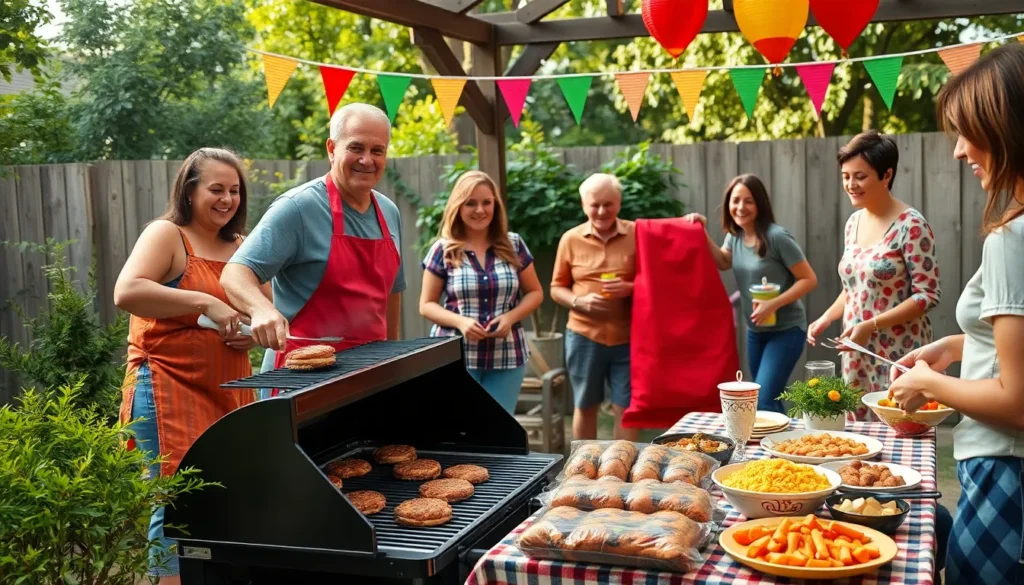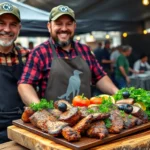Hosting a BBQ for a large group can feel overwhelming but it doesn’t have to be. We’ve all been there – standing in front of the grill wondering how we’ll possibly feed everyone without burning half the food or running out of propane halfway through.
The secret to successful crowd BBQ isn’t just about having a bigger grill. It’s about strategic planning smart cooking techniques and understanding how to scale your favorite recipes without sacrificing flavor. From choosing the right cuts of meat to timing everything perfectly we’ll show you how to transform your backyard into a BBQ paradise that’ll have your guests talking for weeks.
Whether you’re feeding 20 people or 100 the principles remain the same – preparation is everything. With the right approach you’ll spend less time stressed over the grill and more time enjoying the party you worked so hard to create.
Plan Your BBQ for a Crowd Menu Strategically
Smart menu planning transforms a potentially chaotic crowd BBQ into a smooth, enjoyable experience for everyone. We’ll help you make strategic choices that maximize flavor while minimizing stress.
Choose High-Yield Cuts of Meat
Pork shoulder and beef brisket deliver the most bang for your buck when feeding large groups. These cuts yield approximately 50-60% of their raw weight after cooking, meaning a 10-pound pork shoulder serves about 16-20 people generously.
Chicken thighs outperform breasts for crowd cooking since they stay moist longer and cost significantly less per pound. We recommend buying whole chickens and breaking them down yourself to save 30-40% compared to pre-cut pieces.
Ground meat options like burgers and sausages cook quickly and appeal to almost everyone. Plan for 1/3 pound of ground beef per burger, but consider mixing in 20% ground pork for extra flavor and moisture retention.
Ribs require special consideration since they’re mostly bone. Calculate 1 pound of raw ribs per person, or 3-4 individual ribs for lighter eaters. St. Louis style ribs offer more meat per rack than baby backs.
Include Vegetarian and Dietary-Friendly Options
Plant-based proteins ensure every guest feels included in your BBQ feast. Portobello mushroom caps, veggie burgers, and marinated tofu steaks all grill beautifully alongside traditional meats.
Grilled vegetables serve double duty as sides and vegetarian mains. Corn on the cob, bell peppers, zucchini, and eggplant require minimal prep and add colorful variety to your spread.
Gluten-free alternatives accommodate guests with dietary restrictions without extra work. Offer corn tortillas instead of flour ones, and check that your rubs and sauces don’t contain wheat-based ingredients.
Dairy-free sides expand your inclusive menu without sacrificing flavor. Vinegar-based coleslaws, oil and herb potato salads, and grilled fruit desserts satisfy various dietary needs while complementing smoked meats perfectly.
Calculate Portions Based on Guest Count
| Guest Count | Total Meat Needed | Sides Per Dish | Beverages |
|---|---|---|---|
| 20 people | 10-12 pounds | 3-4 quarts each | 40-50 drinks |
| 50 people | 25-30 pounds | 8-10 quarts each | 100-125 drinks |
| 100 people | 50-60 pounds | 15-20 quarts each | 200-250 drinks |
Appetite varies significantly based on event timing and guest demographics. Dinner parties require 25% more food than lunch gatherings, while all-male groups typically consume 20% more than mixed groups.
Side dishes should complement your protein choices without overwhelming the menu. We recommend 3-4 sides maximum, with each recipe scaled to provide 6-8 ounces per person.
Beverage planning prevents last-minute store runs and keeps guests happy. Stock 2-3 drinks per person for events lasting 3-4 hours, including water, soft drinks, and adult beverages if appropriate.
Buffer portions by 10-15% to account for varying appetites and potential last-minute additions to your guest list. Extra food beats running short every time.
Invest in the Right Equipment for Large-Scale Grilling

Having the right equipment transforms your crowd BBQ from a stressful marathon into a manageable cooking experience. Let’s explore the essential gear that’ll help you serve delicious food to large groups efficiently.
Size Up Your Grill or Consider Multiple Units
Cooking capacity becomes your biggest challenge when grilling for crowds. For large groups, we recommend a grill with at least 400-500+ square inches of cooking area to handle the volume effectively. Two-burner grills work perfectly for up to four people, but bigger crowds demand at least a three-burner gas grill or larger models with four or more burners.
Multiple burners allow you to cook different items simultaneously while accommodating indirect heat cooking techniques for whole chickens or ribs. Gas grills offer easier temperature control and quicker heat-up times, making them ideal for large-scale convenience when you’re managing multiple dishes.
Charcoal grills deliver that classic smoky flavor but require more attention and time management during busy cooking sessions. Consider using multiple smaller grills or combining different types like gas and charcoal to manage various cooking styles while increasing your total cooking capacity.
Stock Essential BBQ Tools and Accessories
Long-handled stainless steel tongs serve as your primary food handling tool for safely managing hot items without getting too close to the heat. Sturdy spatulas designed for flipping ensure you can turn burgers, chicken, and fish without breaking them apart.
Digital meat thermometers eliminate guesswork by ensuring food reaches safe internal temperatures while achieving desired doneness levels. Grill brushes for cleaning grates after cooking maintain your equipment and prevent off-flavors from transferring to fresh food.
Heat-resistant gloves protect your hands during extended grilling sessions when handling hot grates or moving items around. Separate cutting boards designated for raw and cooked items prevent cross-contamination, while large trays help transport finished food safely to serving areas.
Set Up Prep Stations and Food Safety Areas
Separate prep stations for raw versus cooked foods prevent dangerous cross-contamination that can make your guests sick. Organize your workspace with designated areas for different food types, keeping raw meats away from ready-to-eat items.
Handwashing stations or sanitizers must be easily accessible for anyone handling food during the event. Proper food temperature controls require keeping cold items chilled until they’re ready to grill and maintaining hot foods at safe temperatures after cooking.
ANSI certified or NSF approved equipment becomes essential for organized or public events where food safety regulations apply. Temperature monitoring systems help you track food safety throughout the cooking and serving process, ensuring every guest enjoys safe, delicious BBQ.
Master the Art of Batch Cooking and Timing
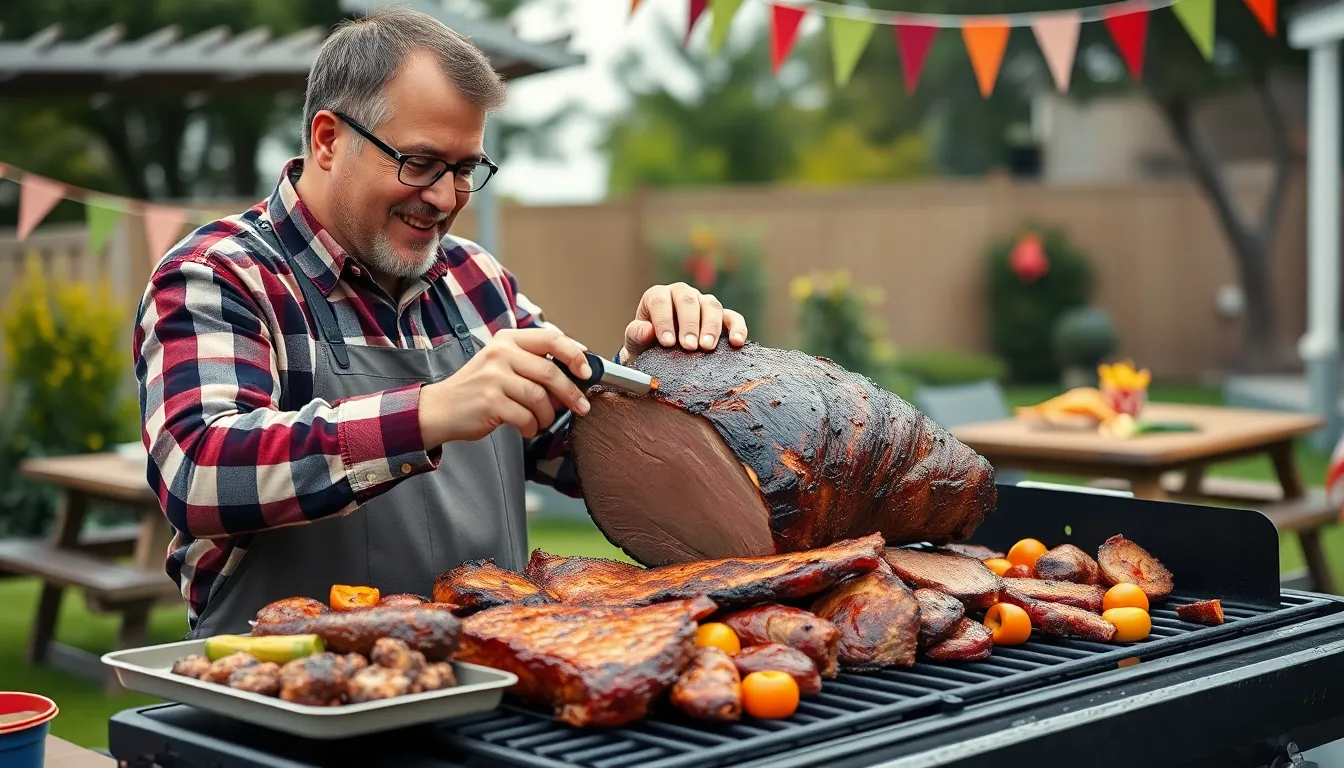
Success in crowd BBQ depends on strategic timing and efficient batch cooking methods. We’ll transform your large-scale grilling from chaotic juggling act into a smooth, well-orchestrated event.
Start Low-and-Slow Items Hours in Advance
Begin your toughest cuts first by firing up the grill for items like brisket, ribs, and rump of beef several hours before guests arrive. These protein powerhouses require extended cooking times to break down tough fibers and develop that signature BBQ tenderness we all crave.
Plan for 6-8 hours when cooking whole rump of beef using low and slow methods until it reaches optimal internal temperature. We recommend starting these cuts early in the morning for evening events, allowing ample time for the magic to happen.
Use the whole-then-portion strategy by cooking large cuts intact, then finishing with a high-heat char before slicing for individual servings. This approach maximizes flavor development while ensuring consistent results across every plate.
Create a Cooking Timeline and Schedule
Map out your cooking sequence starting with the longest-cooking items and progressively adding quicker options like chicken wings, vegetables, and hot dogs. This systematic approach prevents the common mistake of having some dishes ready while others lag behind.
Organize your grilling station with all necessary tools, marinades, and ingredients within arm’s reach before lighting the first burner. We’ve found that this preparation step eliminates mid-cooking scrambles that can derail your timing.
Control temperature zones across your grill surface to manage multiple dishes simultaneously, dedicating high-heat areas for searing and moderate zones for gentle cooking. Smart zone management allows us to cook different proteins at their optimal temperatures without compromise.
Use Holding and Warming Techniques
Keep finished dishes at safe serving temperatures using low ovens set to 200°F, warming trays, or tightly covered aluminum pans. These holding methods maintain food quality while preventing dangerous temperature drops that could compromise food safety.
Batch cook in stages to ensure fresh, hot food throughout your event rather than serving everything at once and watching it cool. We recommend cooking 60-70% of your total portions initially, then preparing fresh batches as needed.
Use resting periods for meats by wrapping them in foil and storing in insulated coolers, which keeps proteins warm while allowing juices to redistribute for maximum tenderness and flavor.
Prepare Make-Ahead Sides and Accompaniments
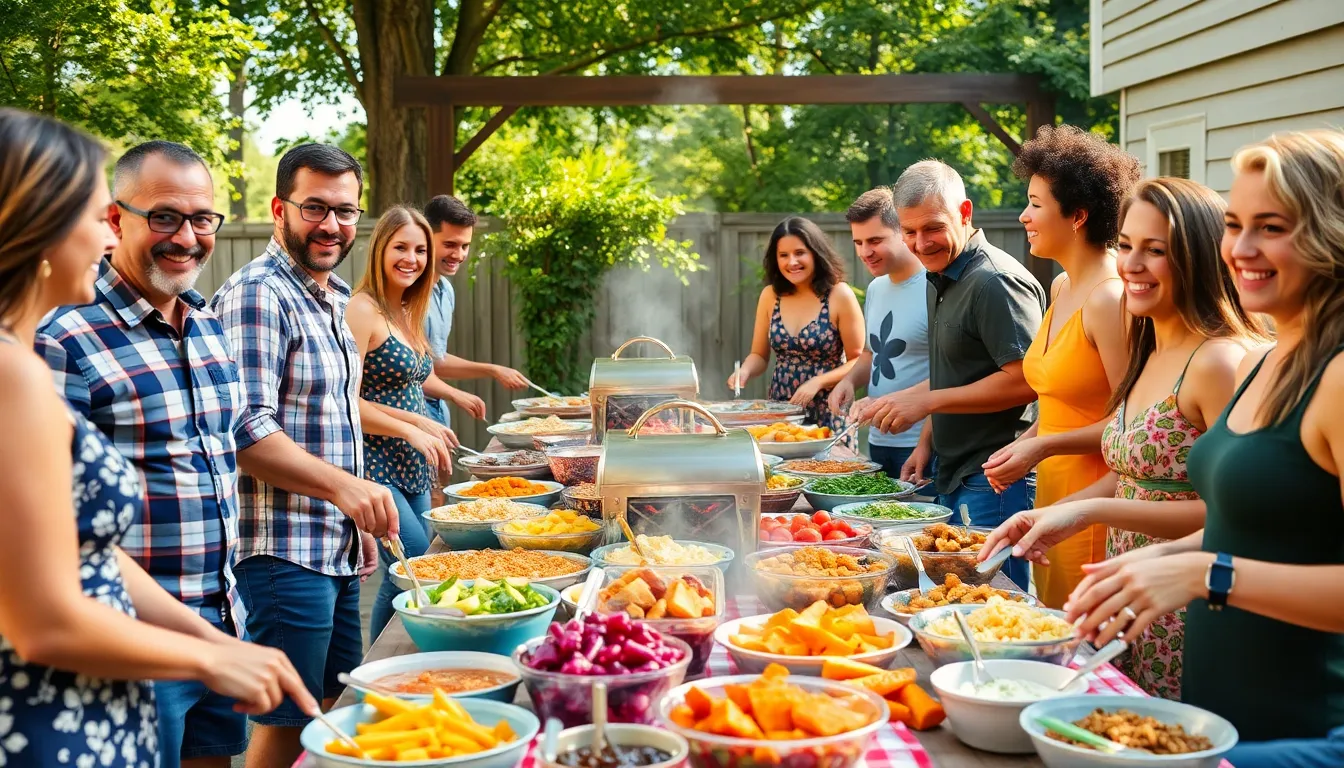
We can streamline our BBQ serving process by preparing sides and accompaniments in advance. This approach reduces last-minute work and allows us to focus on grilling the main dishes perfectly.
Batch-Prep Salads and Cold Dishes
Salads and cold dishes scale exceptionally well for large groups and can be prepared entirely ahead of time. We should choose recipes that hold up well without wilting or losing texture, such as coleslaw, pasta salad, or grain-based salads. Examples like marinated vegetable salads, quinoa tabbouleh, and classic potato salad actually improve in flavor when made the day before. Preparing these dishes ahead ensures quick service and frees up valuable grill space for our proteins. Cold dishes also provide refreshing balance to hot grilled items, making them crowd favorites during outdoor events.
Choose Sides That Scale Up Easily
Picking sides that multiply easily without added complexity saves us important time and effort. Items like mac and cheese, corn on the cob, baked beans, and roasted potatoes are ideal because they cook well in bulk and appeal to virtually everyone. These universally enjoyed dishes simplify our ingredient shopping and cooking logistics since we’re working with familiar recipes in larger quantities. Baked potatoes can be wrapped in foil and cooked directly on the grill, while casserole-style sides like baked beans can be prepared in large Dutch ovens or disposable aluminum pans.
Set Up Self-Serve Stations
Creating buffet-style, self-serve stations dramatically improves traffic flow and reduces waiting times for our guests. We should establish separate areas for main dishes, sides, drinks, and desserts to prevent crowding at any single location. This arrangement allows guests to customize their plates according to their preferences while encouraging a relaxed atmosphere. Consider positioning drink stations away from the main food line and arranging food tables in a logical sequence that guides guests through their meal selection naturally.
Organize Your BBQ for a Crowd Logistics
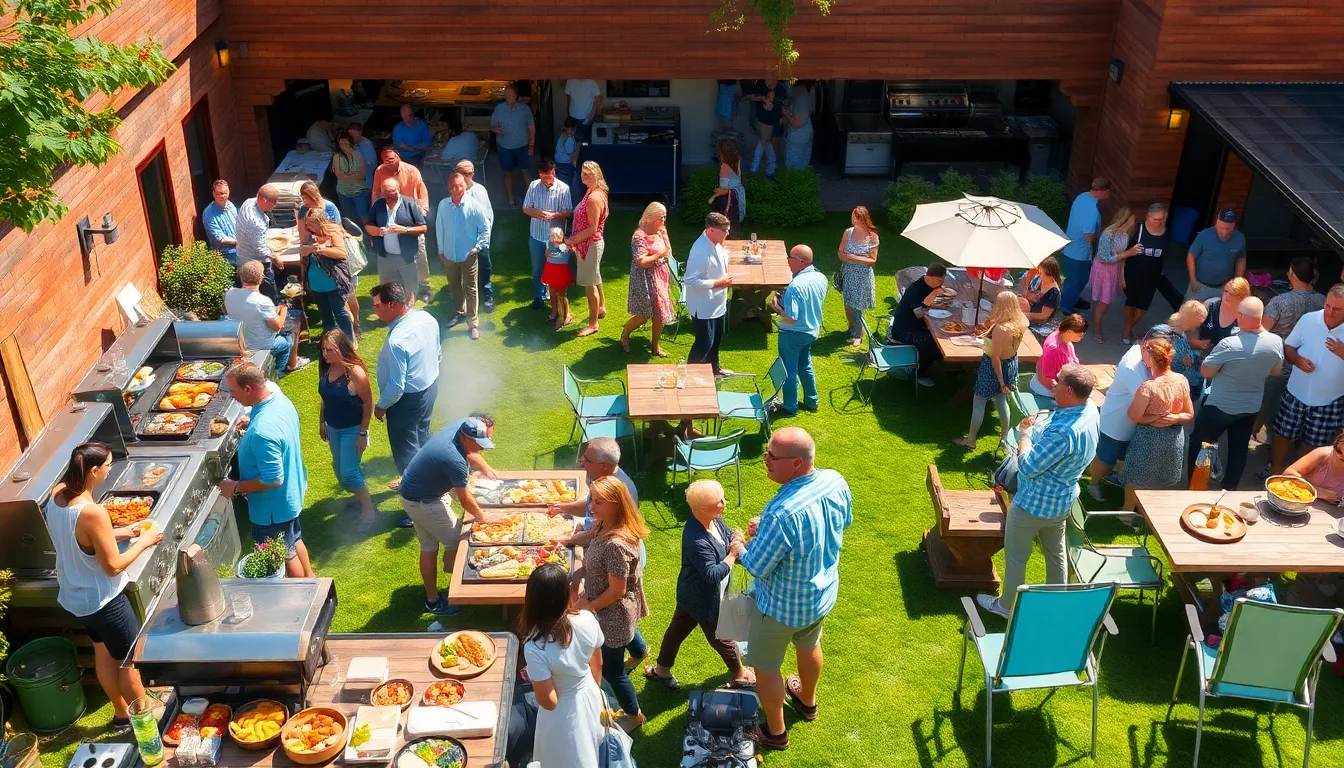
Successful BBQ logistics require careful organization of your space and resources to create smooth operations. We’ll break down the essential elements that separate chaotic cookouts from well-orchestrated events.
Designate Cooking and Serving Zones
Separate cooking and serving areas to streamline food preparation and reduce congestion around your grills. Position your grilling stations at least 10 feet away from buffet tables to prevent bottlenecks and ensure guest safety around hot equipment.
Create distinct zones for different cooking methods by setting up multiple stations if you’re using various grills or cooking techniques. Establish a prep zone near your kitchen for easy access to seasonings, marinades, and fresh ingredients while keeping raw foods separate from cooked items.
Set up your buffet layout using large tables or multiple connected tables to accommodate all dishes without overcrowding. Place serving utensils at each dish and create clear pathways around the buffet area to prevent guests from clustering in one spot.
Position your drink station separately from the main food buffet to improve traffic flow and reduce waiting times. Stock this area with ice, beverages, cups, and napkins to create a self-service setup that keeps guests moving efficiently.
Plan for Adequate Seating and Table Space
Calculate seating requirements by rounding your guest count up to the nearest 10 and ensuring you have at least 80% covered seating for comfort. Mix seating options like picnic tables, lawn chairs, and blankets to accommodate different preferences and group sizes.
Consider traffic flow patterns when placing furniture to avoid creating bottlenecks between cooking areas, serving stations, and seating zones. Leave at least 3 feet of walking space between furniture pieces to allow guests to move comfortably with plates and drinks.
Add ambient lighting with string lights or lanterns if your event extends into evening hours to create a festive atmosphere while ensuring safety. Solar powered options eliminate the need for electrical connections and provide consistent illumination throughout the event.
Create conversation areas by grouping seating in clusters of 4-6 people rather than long rows to encourage social interaction and make guests feel more comfortable.
Coordinate Cleanup and Waste Management
Set up clearly marked stations for trash and recycling in multiple locations throughout your event space to encourage proper waste disposal. Place bins near high traffic areas like the buffet, drink station, and main seating areas for maximum convenience.
Assign cleanup roles to family members or hire additional help for post event cleanup to ensure your space returns to good condition quickly. Create a cleanup timeline that addresses different phases: during the event, immediately after, and final deep cleaning.
Provide disposal supplies like wet wipes, paper towels, and hand sanitizer at strategic locations to help guests clean up spills and maintain hygiene throughout the event. Stock extra trash bags and recycling containers to handle overflow during peak eating times.
Plan waste removal logistics by arranging for additional garbage pickup or designating someone to transport full bags to permanent disposal sites. Consider composting options for food scraps if available in your area to reduce overall waste volume.
Stock Up on Supplies and Essentials
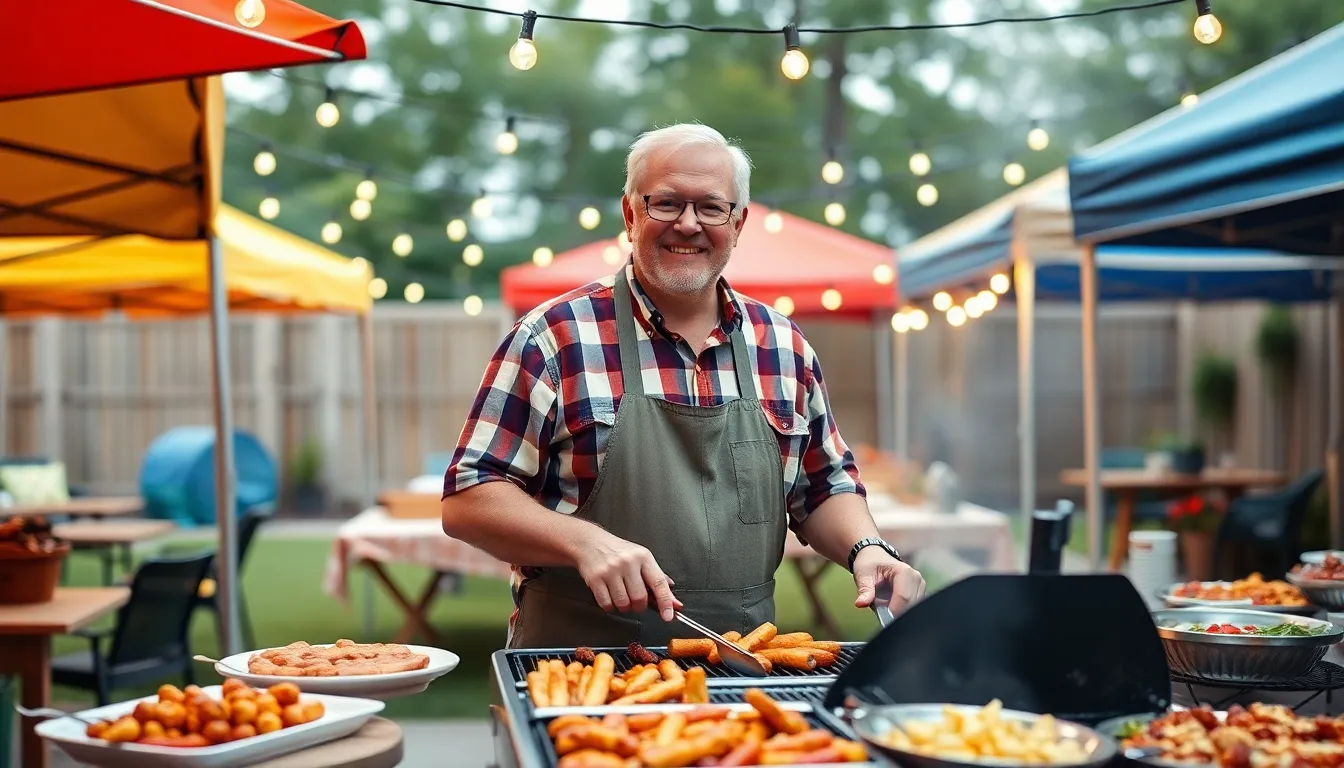
Running out of fuel or forgetting essential serving pieces can derail even the best planned BBQ. We’ll cover the critical supply categories that keep your crowd fed and your event running smoothly.
Calculate Charcoal, Propane, and Fuel Needs
Round up your guest count to the nearest multiple of 10 for fuel calculations to avoid shortages and ensure leftovers. This buffer approach accounts for varying appetites and unexpected arrivals without leaving you scrambling for more fuel mid-cook.
Estimate fuel consumption based on your total cooking time rather than just the number of guests. Low and slow items like brisket require 12-16 hours of consistent heat, demanding significantly more charcoal or wood than quick grilling sessions.
Plan for extended cooking periods by stocking extra fuel beyond your initial calculations. Weather conditions, wind, and temperature fluctuations can increase fuel consumption by 25-30% compared to ideal grilling conditions.
Stock multiple propane tanks if you’re using gas grills, keeping at least one backup tank on hand. Running out of propane during peak cooking time can delay your entire meal service and leave guests waiting.
Gather Serving Utensils and Platters
Organize your serving station with dedicated tongs, spatulas, and heat resistant gloves for each type of protein. Cross contamination becomes a serious concern when serving large groups, making separate utensils essential for food safety.
Set up ample platters and warming trays to maintain food temperature throughout your service period. Chafing dishes and warming trays keep finished items at safe serving temperatures while you complete other dishes.
Create a buffet style layout with clearly designated areas for different food categories. Separate stations for proteins, sides, and beverages improve guest flow and reduce congestion around serving areas.
Position serving utensils strategically at each dish to eliminate bottlenecks in your serving line. Long handled spoons for sides, sturdy tongs for meats, and appropriate ladles for sauces keep the buffet moving efficiently.
Prepare Backup Plans for Weather
Secure tents or marquees as primary weather protection for both guests and food service areas. Weather contingencies become critical when cooking outdoors for large groups, where moving indoors isn’t always feasible.
Install string lights or lanterns if your BBQ extends into evening hours. Proper lighting ensures safe food handling and maintains the festive atmosphere regardless of natural light conditions.
Establish covered prep areas where you can continue food preparation even during light rain or intense sun. Protected workspace keeps your cooking timeline on track when weather doesn’t cooperate.
Arrange multiple trash and recycling stations throughout your venue to maintain cleanliness in any weather. Strategic placement prevents waste buildup and keeps your outdoor space presentable for guests.
Delegate Tasks and Get Help
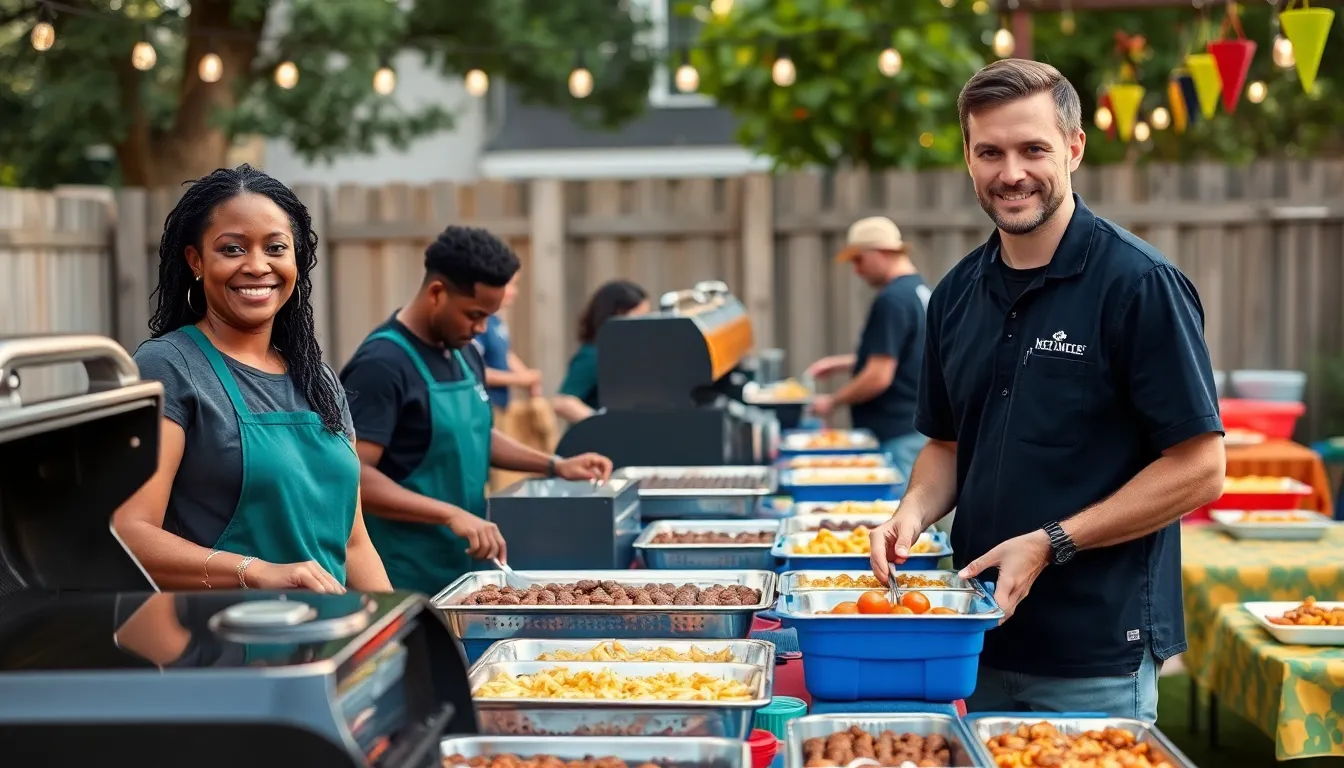
Successfully managing a BBQ for a crowd requires smart task delegation and strategic helper coordination. We’ll transform our overwhelming cooking duties into manageable responsibilities that volunteers can handle efficiently.
Assign Exact Roles to Volunteers
Grill management becomes effortless when we assign dedicated volunteers to oversee cooking stations. We should designate experienced helpers to monitor temperature zones and manage meat rotations while ensuring food safety protocols. Helper teams work best when they understand their exact cooking responsibilities and timing requirements.
Side dish coordination keeps our buffet stations fully stocked throughout the event. We can assign volunteers to handle potato salad refills, vegetable tray arrangements, and bread basket maintenance. These helpers should monitor serving levels and coordinate with our main cooking team for timing.
Beverage station management prevents guest bottlenecks and maintains drink availability. Our volunteers can handle ice replenishment, dispenser cleaning, and cup restocking duties while monitoring consumption patterns. Station managers should coordinate with other helpers to ensure smooth traffic flow around drink areas.
Create Simple Job Lists for Helpers
Written task descriptions eliminate confusion and ensure consistent helper performance throughout our event. We should provide clear instructions like “refill drink dispensers every 30 minutes” or “set up plates and utensils at buffet stations.” Job lists prevent task overlap and help volunteers understand their exact timing requirements.
Checklist formats make helper responsibilities trackable and manageable for large group coordination. Our task lists should include exact quantities, locations, and completion deadlines for each assigned duty. Helpers appreciate knowing exactly what we expect and when tasks should be finished.
Visual guides and station maps help volunteers navigate our BBQ setup efficiently. We can create simple diagrams showing supply locations, trash stations, and equipment storage areas. Clear signage reduces helper questions and keeps our operations running smoothly.
Set Up Beverage and Condiment Stations
Separate drink areas reduce crowding around our main food serving lines and improve guest flow. We should position beverage stations away from grilling areas using large dispensers with easy access to ice and cups. Station placement should consider traffic patterns and prevent bottlenecks during peak serving times.
Condiment organization near food lines keeps our buffet moving quickly and reduces guest wait times. We can use chalkboard signs or simple labels to identify different sauces, seasonings, and toppings clearly. Accessible condiment placement minimizes guest questions and helps volunteers restock supplies efficiently.
Self serve stations work best when we provide adequate supplies and clear organization systems. Our beverage areas should include napkins, stirrers, and cleanup materials within easy reach of guests. Strategic placement of trash receptacles near drink stations maintains cleanliness and reduces volunteer cleanup duties.
Execute Your Large Group BBQ Event
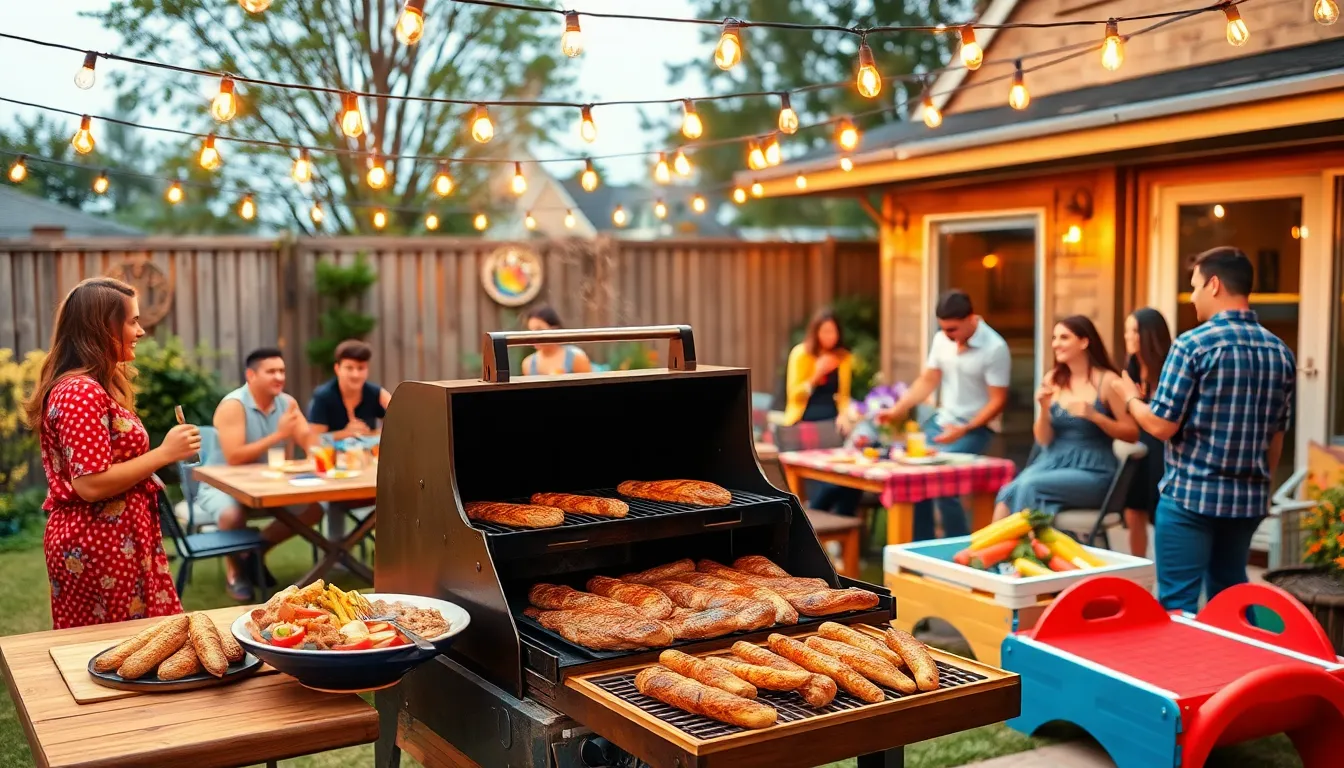
With our planning complete and preparation underway, it’s time to put our large group BBQ strategy into action. Successful execution relies on staying organized, maintaining food safety standards, and keeping guests happy while we work our grilling magic.
Follow Your Timeline and Stay Organized
Embrace the concept of mise en place by having everything in its designated place before we start cooking. Setting up our grilling station, finalizing menu portions, and organizing storage areas well in advance prevents last-minute scrambling that can derail our BBQ timeline.
Checklists become our best friend for tracking supplies and timing throughout the event. We’ll create separate lists for prep tasks, cooking sequences, and serving schedules to ensure nothing gets forgotten during the busy cooking process.
Station setup should include designated food serving tables positioned away from the grill area to reduce congestion. Drink stations work best when placed separately from the food line to prevent bottlenecks and improve guest flow.
Seating arrangements need thoughtful planning to promote natural socializing while maintaining good traffic patterns. Tables positioned at varying angles create intimate conversation spaces while allowing easy access to food and beverage stations.
Monitor Food Temperatures and Safety
Food safety becomes critical when cooking for large crowds since cooking and serving times extend significantly longer than smaller gatherings. We must regularly monitor food temperatures to avoid the danger zone where harmful bacteria multiply rapidly between 40°F and 140°F.
Temperature monitoring systems help us track multiple dishes simultaneously without compromising food safety standards. Digital probe thermometers with wireless capabilities allow us to monitor internal temperatures while managing other cooking tasks.
Hot foods need to stay hot using warming trays or insulated containers, while cold items require proper cooling methods throughout the serving period. Planning our storage strategy for leftovers ensures we can safely preserve excess food promptly after the event concludes.
Cross-contamination prevention requires separate cutting boards, utensils, and prep areas for raw and cooked foods. Hand washing stations positioned near food prep areas help maintain hygiene standards throughout the cooking process.
Keep Guests Engaged While Food Cooks
Creating a festive atmosphere helps guests stay relaxed and entertained during longer cooking times that large group BBQs require. String lights, comfortable seating arrangements, and accessible drink coolers set the stage for an enjoyable waiting experience.
Interactive elements like DIY lemonade stands for kids or lawn games provide entertainment that keeps guests occupied while we focus on cooking. These activities create natural conversation starters and help build community among attendees who might not know each other well.
Music selection should match the event’s energy level while remaining at conversational volume levels. Upbeat background music creates ambiance without overwhelming guests who want to socialize and connect.
Appetizer stations positioned away from the main cooking area give guests something to enjoy immediately upon arrival. Simple finger foods like chips with dips or fresh vegetable trays satisfy initial hunger while building anticipation for the main BBQ feast.
Conclusion
Hosting a successful BBQ for a crowd doesn’t have to be overwhelming when you’ve got the right strategy in place. With proper planning smart equipment choices and batch cooking techniques you’ll transform what could be a stressful experience into an enjoyable celebration.
Remember that preparation is your best friend. From calculating portions to organizing your grilling station every detail matters when you’re feeding a large group. The key is staying organized and keeping food safety at the forefront of everything you do.
Most importantly don’t forget to enjoy the process. BBQing for a crowd is about bringing people together and creating memorable experiences. When you’re well-prepared you’ll have more time to connect with your guests and actually participate in the fun you’ve worked so hard to create.
Frequently Asked Questions
What are the best meat cuts for feeding a large BBQ crowd?
Pork shoulder and beef brisket are ideal for large groups due to their high yield and cost-effectiveness. Chicken thighs retain moisture better than breasts, while ground meats like burgers cook quickly. These cuts provide generous servings and are budget-friendly for feeding 20-100 guests.
How do I calculate portions for a large BBQ?
Plan for about 1/2 to 3/4 pound of meat per person, depending on appetites and event timing. Consider your guest demographics – teenagers and adults typically eat more than children or seniors. Factor in sides and appetizers, which can reduce meat consumption per person.
What equipment do I need for large-scale grilling?
Invest in multiple grills or a large smoker, temperature monitoring systems, and separate prep stations for raw and cooked foods. You’ll also need adequate coolers, serving utensils, and food warming trays to maintain proper temperatures and ensure food safety.
How far in advance should I start preparing for a large BBQ?
Begin planning 2-4 weeks ahead for guest count and menu. Start food prep 2-3 days before, including marinating meats and preparing sides. Create a detailed cooking timeline starting the day before, with low-and-slow items like brisket beginning early morning of the event.
How do I keep guests entertained while food is cooking?
Set up appetizer stations, create interactive elements like games or music playlists, and designate social areas with comfortable seating. Consider having drinks readily available and organizing activities that don’t require constant host attention, allowing you to focus on cooking.
What food safety measures are crucial for large BBQ events?
Use separate prep stations for raw and cooked foods, maintain proper temperatures with monitoring systems, and have adequate refrigeration. Keep hot foods above 140°F and cold foods below 40°F. Plan proper storage for leftovers and ensure clean utensils for serving.
Should I include vegetarian options at my BBQ?
Yes, always include vegetarian options to accommodate all guests. Grilled vegetables, plant-based burgers, and meat-free sides ensure everyone has something to enjoy. This shows thoughtfulness and prevents guests from feeling excluded from the meal.
How do I manage cooking timing for multiple dishes?
Create a detailed cooking timeline working backwards from serving time. Start slow-cooking items like brisket early, then add quicker-cooking items. Use batch cooking techniques and organize your grilling station for efficiency. Consider enlisting help for timing coordination.

